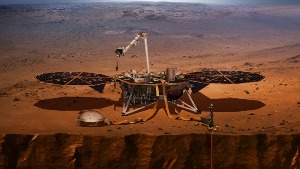
It was an agonizing 6.5 seconds. The members of the InSight lander mission team and NASA officials waited with bated breaths as the $850 million lander shot through Mars’ atmosphere at 12,300 mph, entering at precisely 12 degrees. InSight’s heat shields endured temperatures of 2,700 degrees Fahrenheit. Atmospheric forces managed to decelerate the lander before it parachuted down, towards the surface of the Red Planet.
The InSight lander is an extraordinary feat of engineering. It contains various precise scientific instruments that, provided everything goes smoothly, will send groundbreaking data back to Earth on the interior of Mars, which has previously been unexplored. This will, in turn, help researchers understand other rocky planets as well.
The main instruments are the seismometer, the heat probe, and communications gear. The seismometer, called the Seismic Experiment for Interior Structure, was developed by France’s National Center for Space Studies (CNES) and will be used to measure marsquakes. The seismometer is so powerful it can detect waves of vibration the size of a single atom.
The German Aerospace Center contributed the heat probe, named the Heat Flow and Physical Properties Probe (HP3). The probe will measure the internal temperature of Mars 16 feet in.
Both of these instruments will not be used for another six months, however. The heat probe and the seismometer will be deployed by InSight, a first for a Mars spacecraft. Previous missions have been completed with the instruments attached to the crafts. The lander’s mission team will first need to locate InSight, before recreating the Mars terrain at their NASA base. There, they will practice with a full-size model until they perfect the deployment of the two instruments.
The communication gear, RISE (Rotation and Interior Structure Experiment), will send information on the wobble of Mars, among other information. From this, astronauts will be able to deduct the physical state of Mars’ core, whether it is liquid or solid.
The data from these instruments will help researchers understand the interior of the Red Planet. “That is the goal of the InSight mission — to actually map out the inside of Mars in three dimensions, so that we understand the inside of Mars as well as we have come to understand the surface of Mars," stated InSight principal investigator Bruce Banerdt.
Monday’s landing was crucial. InSight had to enter Mars’ atmosphere at exactly 12 degrees, or else risk bouncing off the atmosphere or scorching to a crisp. The location of the landing was also pivotal. A terrain with lots of rocks might damage the heat probe.
InSight landed on the Elysium Planitia at 5 mph, slightly off target, but unharmed. Despite being off target, InSight managed to avoid a rocky landing by ending up on a soil filled crater out of sheer luck. The lander has sent back several pictures of its new home. On Tuesday, InSight’s team received data that the solar panels had successfully been deployed. It could not have been a better start to a revolutionary mission.
[Sources:
Science.com
;
Sciencemag.org
]

